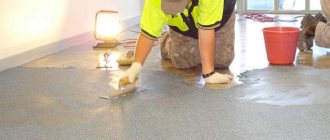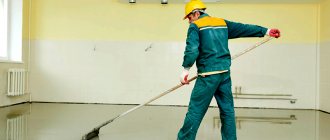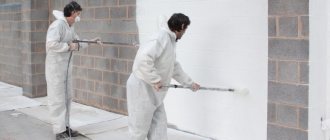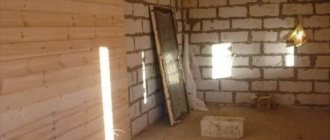Polymer paints are used to protect concrete and prevent it from dusting. In addition, such materials give the base a decorative effect. The result is a thin polymer coating that can withstand moderate and normal loads. The technology for applying such compositions is extremely simple. Painting is done in one or several layers.
Why paint concrete
Despite the progressive development of construction technologies, concrete still remains the most common material. However, this artificial stone has a number of disadvantages, including a porous top layer that is subject to wear and tear and an unsightly appearance.
To ensure an attractive appearance and the longest possible service life, painting becomes one of the simplest, most convenient and affordable solutions . This solution is in demand everywhere and has proven its practical and financial effectiveness.
In addition to protective properties, coloring also imparts decorative qualities to concrete.
What can you paint with?
After one difficulty - pouring, the next one arises - painting the frozen self-leveling floor. Applying a paint and varnish composition will help improve the appearance of the resulting surface and give it additional strength and durability.
Note! Coating with paint will protect the surface from cracks and chips and increase its service life.
Compositions can be used alkyd or epoxy. They, among other things, provide an anti-slip effect. This has a great effect on ease of use. Another important point is that a floor with such a coating does not get dirty for a long time - dust settles on it less intensively. The antistatic effect contributes to this.
Pouring self-leveling compound
Types of polymer paints for concrete
To protect concrete structures, a number of standard polymer coating systems based on acrylic, epoxy, and polyurethane are used. Additional materials are represented by strengthening impregnations and primers and repair compounds.
The choice of one solution or another is based on the condition and quality of the base, requirements for operational properties, and the service life of the coating . Depending on the decorative effect, a colorless or colored coating is used. For low-quality and weak concrete, polymer impregnation is necessarily used.
When choosing a material, you should first determine the intensity of abrasive, chemical-mechanical, and impact loads that will act on the base. Of primary importance is the quality of concrete and its strength . Not only the type of polymer paint and varnish compositions, but also their consumption depends on this. For example, it is enough to apply polymer enamel to high-quality compacted high-strength concrete, without the participation of impregnations.
Advantages of concrete coated with polymer paints:
- 100% dust removal;
- quick commissioning;
- resistance to solutions of acids, alkalis, detergents;
- wear resistance and high mechanical strength;
- operating temperature from – 60 to + 60 degrees;
- some types of coatings can be applied at sub-zero temperatures;
- the floor is accessible for pedestrian traffic after a day, for full chemical and mechanical load – after three days;
- versatility (trade, warehouse, industrial premises, parking lots, hangars, car services, parking lots, wood processing, mechanical engineering, energy, pharmaceutical, medicine, markets, storage facilities;
- impregnations paired with polymer paints can be applied outdoors.
Disadvantages include high requirements for the quality of the base and cost.
Complete dust removal and sealing is provided by the following polymer materials:
- Production facilities, dry process shops , terminals, warehouses, paper mills, woodworking, furniture factories, porcelain factories, glass factories, clothing factories, shoe factories and other light industry:
- when traffic on rubber tracks of moderate intensity requires wear resistance, resistance to mechanical loads - polymer impregnations are used for porous bases + matte or glossy paint for concrete (for the floor) or acrylic analogues;
- the same, but with high load intensity, where it is necessary to ensure wear resistance, resistance to mechanical loads, impact resistance - polymer impregnation + polyurethane primer + polyurethane enamel (for colored floors) or polyurethane varnish are used.
The impregnation-primer-paint scheme is most optimal for all applications
- Premises and production workshops with wet processes , for example, meat, fish shops, meat processing plants, fat factories, dairy plants, sugar factories, pig farms, cowsheds, creameries, breweries, confectionery factories, fish processing shops:
- at moderate intensity of loads, where it is required to ensure resistance to mechanical loads, wear resistance, chemical resistance, impact resistance - polymer impregnation (for porous substrates), polyurethane primer, polyurethane paint is used;
- the same, but with high load intensity - polymer impregnation, polyurethane primer, polyurethane enamel or polyurethane paint, varnish are used.
- Workshops and production facilities with increased floor loads , underground parking lots, garages, car services, engine and machine tool factories, mechanical engineering shops:
- when moving vehicles with average load intensity, to ensure wear resistance, impact resistance, gasoline and oil resistance, abrasion resistance, polymer impregnation, polyurethane primer, polyurethane enamel or paint, varnish are used;
- at high load intensity, to ensure the same properties, polymer impregnation, polyurethane primer, and polyurethane paint are used.
- Industrial premises with chemical loads on the floor , chemical production facilities, oil refineries, mineral fertilizer storage facilities, premises and workshops with aggressive effects of liquids (solvents, oil, salt, alkalis, acids):
- To ensure resistance to mechanical and chemical influences, wear resistance - epoxy impregnation, epoxy primer, epoxy paint are used.
- Floors of freezers, refrigerators , industrial refrigerators:
- To ensure chemical resistance, impact resistance, and wear resistance, polymer impregnation, polyurethane primer, and polyurethane paint are used.
- Stairs, corridors, hotels, exhibition halls , offices, shopping centers:
- To ensure wear resistance and resistance to mechanical loads, polymer impregnation, polyurethane primer, polyurethane paint or acrylic analogues are used.
Epoxy paint for concrete
Two-component epoxy compounds have a short service life after mixing, so they are prepared according to the production time
For painting concrete, it is recommended to use two-component enamels. This is a wear-resistant material that does not contain organic solvents. The basis is a suspension of fillers and pigments in a mixture of epoxy resins and active diluents. The finished layer protects concrete from the action of aggressive compounds (solutions of acids, alkalis, detergents, diesel fuel, mineral oils, gasoline), abrasive wear, and gives an aesthetic appearance.
A distinctive characteristic is ease of application and high spreadability. Epoxy enamel can hide minor unevenness and defects in the base. It is used for treating old and new concrete, including surfaces that were previously treated with epoxy paints . Average consumption – 160-200 g/m². In practice, the outcome depends on the application method, surface roughness and porosity.
Advantages of the material:
- elasticity;
- water resistance, chemical resistance;
- impact resistance;
- petrol, oil resistance;
- high spreadability;
- high decorative properties;
- convenience and ease of application;
- it is possible to implement a thin-layer coating of 500 microns;
- operating temperature -40 +100 degrees;
- no odor;
- colors according to the RAL palette.
Flaws:
- short viability.
Preparing the base
How long the floor will last primarily depends on the quality of the preparatory stage. Make sure that all debris, remnants of old paint, dirt, bitumen, stains from varnish and all kinds of fuel and lubricant mixtures are removed from the base. It is easy to remove such marks with detergents until the water on the floor stops collecting into separate drops.
All concrete crumbs must be removed from the floor, after which you can begin to putty all the depressions, and then grind them with any special grinding machines (read: “How and how to grind a concrete floor - instructions for doing the work yourself”). These measures will improve the adhesion of the finishing layer to the floor. It is best to remove dust with a vacuum cleaner, or at worst with a simple mop.
Toppings are used as strengthening impregnation. They are dry mixtures that include quartz, cement, plasticizers, dyes and other additives. Strengthening mixtures can be used as a decorative treatment for the floor, making it smooth and glossy.
Acrylic paint for concrete
Acrylic paints are water-based, that is, it is an aqueous dispersion based on acrylic resins , which also includes special polymer additives. The material successfully prevents the destruction of concrete by forming a polymer film. The result is a durable and durable coating.
Acrylic paint is used for treating balconies, basements, garages, stairs, etc. This is the optimal solution for normal and medium loads, especially in conditions of high humidity and where sanitary and hygienic requirements are required.
Acrylic compounds are used indoors and outdoors at pharmaceutical and food industry enterprises, in warehouses, in retail, utility rooms, when covering enclosing structures, monuments, fences, and non-critical industrial premises. The paint is suitable for covering floors and walls.
The average consumption of acrylic compounds for concrete is 0.3-0.4 kg/m²
Advantages of the material:
- high weather resistance;
- protection of concrete from corrosion and dust formation;
- moisture resistance, waterproof;
- quick drying, environmentally friendly;
- convenient and easy application.
Flaws:
- Compared to other polymer compounds, the material is less resistant to chemicals.
How to paint a self-leveling floor, choosing a composition, stages of work
The convenience of a self-leveling floor is undeniable - it is durable and reliable, but the beautiful qualities of the coating are not always high. This raises the question of whether it is even possible to paint a 3D floor. The paint will help make the surface smooth and shiny. To ensure that such a floor does not lose its own parameters, the paint and varnish composition must resist abrasive and physico-chemical influences.
Self-leveling floor without painting
Polyurethane paint for concrete
This group of concrete materials does not contain organic solvents. One-component polyurethane enamels create a wear-resistant coating that is cured by air moisture . This is a good option for rooms with high loads, low water permeability, and high resistance to most chemicals. You can appreciate the high decorative characteristics.
Polyurethane paints are used in retail and warehouse premises, garage complexes, car service centers, car washes, public and medical institutions. Average consumption is 130-160 g/m², with a layer thickness of 80-100 microns.
Advantages of the material:
- wear-resistant glossy coating;
- water resistance;
- impact resistance;
- matte and glossy texture;
- ability to repel dirt;
- resistance to gasoline, oils, chemicals, mechanical and pedestrian loads;
- durability in harsh operating conditions;
- it is possible to apply a layer up to 120 microns;
- application from – 10 degrees;
- decorativeness.
Flaws:
- high price;
- the material is inferior to epoxy compounds in elasticity.
Table 1. Technical characteristics of polymer paints for concrete
| Name | Epoxy | Polyurethane | Acrylic |
| Compound | Suspension of fillers and pigments on an epoxy compound | One-component material based on polyurethane polymers without organic solvents | Aqueous dispersion of fillers and pigments based on acrylic resins |
| Mass. share of non-volatile substances, % | 99 | 99 | 57-62 |
| Drying time at t +20 degrees up to 3 tbsp., h | 12 | 10 | 1 |
| Covering capacity, g/sq.m | 80 | — | — |
| Film strength upon impact, cm | 50 | 50 | — |
| Film bending strength, mm | 2 | 2 | — |
| Resistance to water, h | 72 | 72 | 24 |
| Resistance to fuels and lubricants, h | 72 | 72 | — |
| Grinding degree, µm | 80 | 80 | 60 |
Operating mode of polyurethane paints +60+100 degrees
Tools and equipment for applying paints
To ensure a high-quality result, it is necessary to choose the right set of tools.
To work with polymer compounds, the following is used:
- flat synthetic brushes - for acrylic paints;
- brushes based on bristles and horsehair - for polyurethane and epoxy compounds;
- Fur rollers (sheepskin, velor) with medium pile are a universal tool for all types of polymer paints. For large areas, samples with a length of 18 cm and a diameter of more than 40 mm are used;
- sliding telescopic handles;
- trays and grids for removing excess;
- spray gun;
- squeegee;
- for preliminary preparation of the base you will need a grinding machine, a high-pressure washer, a sandblasting machine, and an industrial vacuum cleaner;
- To protect workers, you will need special clothing, safety shoes, respirators, goggles, and gloves.
Surface care
Since polymer compounds have the ability to repel dust and dirt, caring for the coating is easy.
Painted concrete surfaces are easy to clean using basic detergents. Some compositions are resistant to aggressive substances. The widespread use of polymer paints when painting concrete is due to their good protective properties, as well as decorative qualities. The cost of such materials is acceptable and, if the painting technology is followed, it will be possible to provide reliable, long-lasting protection of the concrete surface.
Technology of floor painting with polymer paints
The concrete base must meet the requirements of building rules and regulations, in particular SNiP 3.04.03-87 “Insulation and finishing works”, SNiP 2.03.13-88 “Floors”.
Preparation for painting
High-quality preparation is one of the factors that allows you to obtain high-quality coverage. Failure to comply with the regulations at this stage can lead to peeling and swelling of the paint. If we talk about new concrete, it contains a high percentage of structural moisture, so it is recommended to start painting with polymer paints after the end of the first heating season . Before working with paints, concrete must be cleaned of all technological contaminants.
Basic cleaning principles:
- for a small amount of work, dry dust and cement laitance are removed with steel brushes;
- molding oils are removed by washing with water under high pressure;
- cement adhesives - sandblasting. Plus, glossy concrete is wet sandblasted to roughen it;
- open cavities and pores with a diameter of more than 2 mm, weak layers are eliminated using repair solutions;
- cracks are opened, the reinforcement is cleaned of rust by sandblasting or steel brush and immediately coated with an anti-corrosion compound;
- if the base has been painted previously, it is cleaned of dust, dirt, and foreign matter using high-pressure washing. To completely remove the coating, wet sandblasting is used.
Old floors are most often pre-sanded. This will allow you to remove the lime (cement) laitance, the finished layer will lie stronger and smoother
Materials for floor repair under polymer paints
- polyurethane joint sealants . This material does not shrink, is elastic, provides adhesion and seals seams and cracks. Application is carried out on a dry, clean surface primed with a polyurethane primer. The paste is mixed with the hardener for 3 minutes, after which the composition is filled into the defect with a spatula or pouring. Viability – 40 minutes, strength development – 5-7 days;
- two-component epoxy repair compounds - this solution is suitable for repairing chips, potholes, cracks and removing irregularities. Such compositions are used as an intermediate layer before applying polyurethane and epoxy paints. The total layer thickness can reach 1 cm. The material is applied over pre-mixed soil. Quartz sand can be added to the compound (1 kg per 1 kg of finished mixture). Viability – 45 minutes, complete curing – 5-7 days;
- epoxy two-component adhesives - the material is recommended to be used as an intermediate layer between old and new concrete screeds. It forms an adhesive adhesive layer, which reduces the weight of the new screed and labor costs. The adhesive can be applied to damp concrete with oil stains. The mixture is distributed after thoroughly mixing the two components using the pouring method and a squeegee or notched trowel. Removed areas are finished with a brush. Average consumption – 0.4-0.5 kg/m²;
- water-based waterproofing urethane putties (three-component) - the composition is used for waterproofing concrete, repairing cracks, incl. small cobwebs. The material can work on fresh concrete, damp substrates, indoors and outdoors. The components are mixed and spread with a notched spatula or squeegee. Average consumption – 1.5-4.0 kg/m².
Padding
This stage can be divided into two technological processes: the application of impregnations (strengtheners) and the application of primers. Impregnations work to increase wear resistance and strengthen concrete, which is required for maximum loads on the base . In some cases, the hardener helps stabilize concrete, which at first glance should be filled with a new screed. The compositions are applied before the priming stage after surface preparation.
Primers are used on weak and porous substrates, improve adhesion (adhesion) of the finishing layer and reduce paint consumption.
Materials used:
- acrylic primer – used as a preparatory layer before painting with acrylic paint on a dry, clean base. The material is distributed with brushes, rollers, sprayers in 1-2 layers. The layer will dry in 1 hour. Average consumption – 0.2-0.3 kg/m²;
- Strengthening polymer impregnations are liquid hardeners of deep penetration (up to 5 mm or more). They work on old and new concrete. Application is carried out with brushes and rollers. If uneven absorption is detected, another layer is applied. Drying lasts 3-6 hours. Average consumption is 0.2-0.35 l/m²;
- polyurethane primers – one-component compositions for painting with polyurethane paints. Apply with a short-haired fur roller or brush in a uniform thin layer. Leaks and spills are unacceptable. A second coat is applied if uneven absorption is detected. Drying takes 8-12 hours. Average consumption is 0.2-0.25 kg/m²;
- epoxy primer-impregnations – two-component deep penetration compositions for painting with epoxy paints. When preparing, component B is introduced into component A, the mixture is mixed and diluted with water (6-7 l/kg of soil). After repeated mixing, the material is spread by spray, brush or roller. The interval before applying the primer is 12 hours. Viability is 4 hours. Based on this composition, you can prepare the primer, reducing the water content to 1.5-2 liters.
Average consumption of epoxy primer - impregnation for concrete 350-700 g/m²
Test application
Regardless of the recommendations given, a trial application should be carried out. This will allow you to check whether the selected polymer paint is compatible with the base; secondly, this is how you can determine which composition is best to use to protect concrete. Plus, the test will help determine how high-quality the layer will be and the actual consumption of the compositions . After drying, the treated area can be subjected to abrasion, mechanical loads and other influences that exist on a particular object.
To carry out work, you should measure out an area of 1 m², marking its boundaries. The paints are distributed with a fur roller or brush, in accordance with the recommendations for each individual product.
Coloring
Concrete must be clean and dry. Compressive strength – not lower than 15 MPa, tensile strength – 1 MPa, humidity – not higher than 5%. According to the actual condition, the base paint can be applied to a hardened, primed or unprimed surface.
Features of working with two-component epoxy enamels:
- Components A and B are combined and mixed for 2-3 minutes;
- the material settles for 10 minutes, after which it is mixed again;
- viability – 2 hours at t +20 degrees;
- the composition is spread over the concrete with a brush, roller or using airless spraying;
- painting work is carried out at base and air temperature +5+35 degrees;
- layer-by-layer drying is required, the second layer is applied after 8-12 hours;
- pedestrian load is permissible after 24 hours, final load after 3-5 days;
- the instrument is washed with universal solvents, xylene.
Features of working with one-component polyurethane paints:
- You can start applying paint 8-12 hours after applying the primer;
- Before work, the material is thoroughly mixed;
- polyurethane is applied in a layer of up to 120 microns, spreading with a squeegee or roller;
- the second layer is applied after 8-12 hours;
- the instrument is cleaned with xylene and solvent solvents;
- the air and surface temperature should not be lower than -10 degrees, +5 degrees above the dew point. Air humidity – 35-65%.
After painting with polyurethane paints, pedestrian traffic is permissible within 24 hours, final traffic is allowed after 3-5 days.
Features of working with acrylic paints:
- acrylic paint is applied to the cleaned base with rollers, brushes or spray in 1-2 layers;
- if required, the material is diluted to working viscosity with water;
- painting is carried out at a temperature not lower than +5 degrees;
- Complete drying occurs after 12-14 hours.
Safety precautions
When working with polymer materials, you should use protective equipment against fire and explosion hazards, increased levels of static electricity, and elevated temperatures of equipment and accessories.
The microclimate of the work site must comply with the state standard “General sanitary and hygienic requirements for the air of the working area . The equipment used must ensure maximum mechanization of technological stages.
Work with polymer materials is carried out in isolated rooms with supply and exhaust ventilation. Fume hoods are also installed here for storing paints, impregnations, and primers. Persons at least 18 years of age who have been declared fit after a medical examination and who have undergone full instruction are allowed to work.
The personal safety of each employee is ensured by special clothing , safety shoes, gloves, goggles and respirators. To prevent harmful effects, hands are treated with ointment based on lanolin or petroleum jelly, and washed with soap and water every 2 hours.
conclusions
How to choose the optimal solution? There are no universal tips; first of all, you should determine the type of impact on concrete and the intensity of loads in each specific room. But some general recommendations can be given.
If the base is porous, with high absorbency, the “impregnation + primer + paint” system should be used . For rooms with chemical loads, an epoxy polymer composition would be the best choice; for cold conditions, with high shock loads - polyurethane.
If the base requires the use of repair putties, you should be prepared for costs - from 385 rubles / kg
Acrylic is more versatile; it can be used indoors and outdoors for work on walls and ceilings; in addition, this material dries quickly. If the concrete is stable, durable and does not require repair, you can use a polymer composition without impregnations and primers.
You can clearly see the advantages and technology of a polymer floor in a garage in this video:
Painting process
The self-leveling floor must be prepared for painting; if this is not done, the quality of the paint layer on the concrete will not be the highest, and it will certainly not be possible to achieve the stated result. Preparation process for applying coloring compositions:
- Remove debris and dust from the concrete surface.
- Traces of old paint, if any, must be removed.
- To improve adhesion, coat the concrete surface with a primer. In the case of epoxy paint and varnish, this is not necessary.
- Check the moisture level of the floor, especially if it has been recently poured. To do this, stick a piece of polyethylene measuring 10 by 10 cm onto a section of the surface using tape and leave overnight. If condensation has formed during this time, then the floor is not ready yet; it still needs to harden and evaporate moisture.











